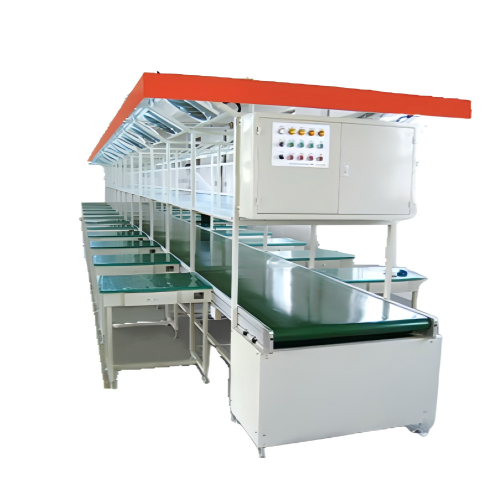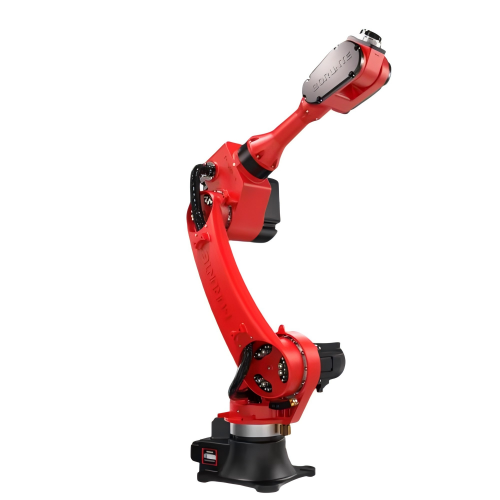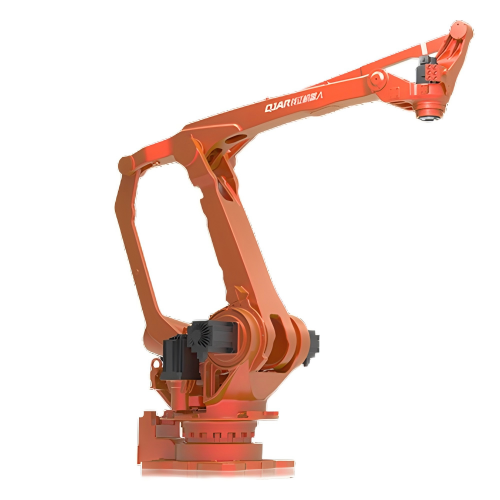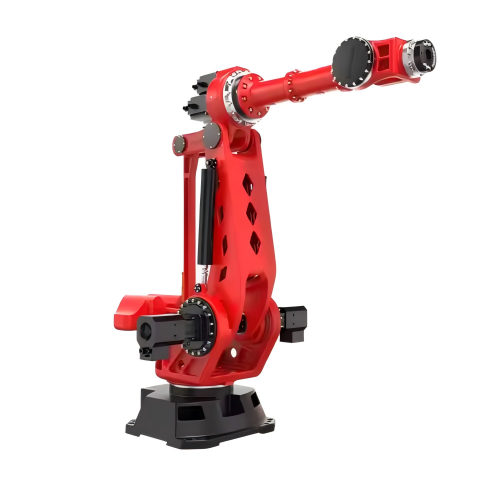
- Wenling zhejiang China
- [email protected]
- +86 18958695512
- Home
- PRODUCTS
- INDUSTRIAL ROBOT
- PALLETIZING ROBOT
- Palletizing Robot 30kg Reach Distance Super Palletizer Arm
Palletizing robot 30kg Reach Distance super Palletizer Robotic Arm

30kg payload 1820mm reaching distance palletizing robotic arm
- High-speed and stable,
- all axis operating at low power output,
- simple equipment composition can be used with special palletizing software.
- Categories: Handling,loading and unloading, packaging,palletizing,picking up
QJRB30-1
CHINA
30DAYS
T/T
NINGBO/SHANGHAI CHINA
| Model | QJRB30-1 | |
| Axis Number | 4 | |
| Payload | 30kg | |
| Repeat Positioning | ±0.05mm | |
| Max Armspan | 1820mm | |

How Do Palletizing Robots Work
Palletizing robots are a cornerstone of modern automated manufacturing and logistics systems. They are designed to load and stack products such as boxes, bags, and cartons onto pallets with speed, precision, and consistency. These robots enhance productivity, reduce labor costs, and improve workplace safety. Understanding how palletizing robots work involves examining their key components, operation sequence, control systems, and integration into broader production environments.
1. Core Components
The typical palletizing robot consists of several primary components:
Robotic Arm: The central mechanical structure that moves and manipulates products. It has multiple axes of movement to allow flexibility in positioning items accurately.
End Effector (Gripper): The tool attached to the end of the robotic arm. It can be a vacuum gripper, clamp gripper, or fork, depending on the product type.
Base and Frame: The foundation of the robot, ensuring stability and support during high-speed operation.
Vision System (optional): Advanced robots include cameras and sensors to detect product orientation, size, and placement location.
Controller and Drive Motors: These components direct the robot’s movements and deliver the power needed for motion.
2. Operate
The operation of a palletizing robot can be broken down into a sequence of automated tasks:
Product Identification and Pickup: The robot identifies a product on the conveyor belt using either fixed-position logic or a vision system. It then picks up the product with the appropriate gripper.
Movement to Pallet Location: The robot’s controller calculates the optimal path and moves the product to a predefined location on the pallet.
Product Placement: The robot places the item in the correct position and orientation, ensuring stability for the pallet stack.
Pattern Repetition: This process repeats according to the programmed stacking pattern (layer-by-layer or interlocked for stability).
Pallet Exchange: Once a pallet is full, the system triggers a conveyor or pallet exchanger to bring in an empty pallet, and the cycle restarts.
3. Programming and Configuration
Palletizing robots are programmed using intuitive software that allows operators to set stacking patterns, adjust for different product sizes, and define pallet dimensions. Key configuration options include:
Stacking Patterns: Column stack, interlocked stack, or custom layouts to maximize load stability and space efficiency.
Load Adjustments: Adjustments for product weight, height, and material to prevent damage during handling.
Speed Settings: Variable speeds for different product types and production volumes.
Some systems also use AI-based optimization to adapt stacking strategies in real time.
4. Integration into Production Lines
Palletizing robots are rarely stand-alone machines. They are part of a larger automated workflow that may include:
Conveyor Belts: Deliver products to the robot’s pickup zone.
Automatic Wrappers: Secure finished pallets for shipping.
Warehouse Management Systems (WMS): Provide tracking and inventory updates.
Safety Systems: Include light curtains, emergency stops, and protective fencing.
This integration enables end-to-end automation from production to packaging and distribution.
5. Safety and Compliance
Palletizing robots are equipped with multiple safety features to protect workers and comply with international safety standards:
Emergency Stop Buttons: Instantly halt all operations if a hazard is detected.
Light Curtains and Fences: Prevent unauthorized or accidental human access to the robot’s operating area.
Collaborative Features (in cobots): Built-in force and speed limitations allow safe interaction with human workers.
6. Benefits
Understanding how these robots work also highlights their many benefits:
Consistent Performance: Robots do not tire or make errors, ensuring consistent quality.
Increased Throughput: Faster operation than manual palletizing.
Labor Savings: Reduces the need for manual labor in repetitive, strenuous tasks.
Reduced Product Damage: Precise handling minimizes breakage.
Space Optimization: Can stack more efficiently, reducing storage costs.
7. Maintenance and Diagnostics
Advanced palletizing robots include self-diagnostic tools and remote monitoring capabilities. They notify operators of:
Wear and tear on mechanical components
Software updates or calibration needs
Emergency error logs for troubleshooting

SHENCHI ROBOT CO.,LTD provide different industrial robot with automation solutions . we support industrial robots including welding, painting, handling, palletizing, bending and polishing, welcome to contact us.
Shenchi robot ,More smart more simple
© Shenchi Company All right reserved.





